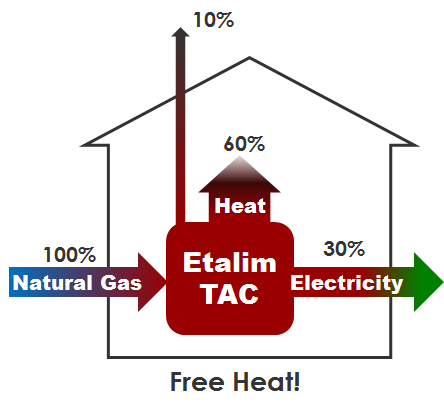Thermoacoustic Cogeneration Engine Development
Lead Proponent: Etalim Inc.
Location: Vancouver, BC
ecoEII Contribution: $ 1,402,550
Project Total: $ 4,914,600
Project Background:

Micro-CHP benefits
Text Version
Etalim
Natural gas into a Etalim TAC produces 60% “free” heat, 30% electricity, and only 10% “wasted” energy
Micro combined heat and power or “micro-CHP” is the simultaneous production of heat and power within a home or small building. Micro-CHP systems are largely differentiated by the prime mover (either an engine or fuel cell) at their heart. One such engine has been developed by Etalim Inc. The “Thermal Acoustic Converter” or TAC has the potential to convert any fuel or heat source to electricity. The TAC is a is a type of heat engine that combines concepts from a Stirling engine with principles of thermodynamics, high-amplitude acoustics, mechanical resonance and materials science in a unique way. The result is a highly efficient and inherently reliable small engine.
Etalim’s unique device also has potential in markets beyond micro-CHP. Waste heat recovery from large engines or industrial facilities, power generation from biogas, landfill gas or other renewable fuels, utility-scale solar power and auxiliary, rural and telecom power generation, are all possible applications for the TAC. To that end, ecoEII awarded $1.4M to Etalim for their project “Thermoacoustic Cogeneration Engine Development”. The project had two main objectives: to complete the development and testing of a pre-commercial beta prototype of the TAC capable of multi-fuel operation, and to integrated the TAC into a micro-CHP system and confirm its operability in a laboratory environment.
Results:
A new TAC architecture, dubbed the “HT”, was conceived early in the project. The HT-TAC consisted of two separate modules: the thermal module (TM) which converted thermal power to acoustic power and the generator module (GM) which converted acoustic power to electrical power. The first prototype HT-TAC was built and tested. It ran at 700⁰C, and accepted heat from an external source (outside of the TAC pressure vessel wall) – a first for Etalim. The HT-TAC also achieved 860 Watts (peak) of mechanical output at 700⁰C, and more than 40 hours of operating time.
A compact natural gas burner was developed to fit the new HT-TAC architecture. The first prototype validated the concept and functionality. The second iteration of the prototype pushed the operational efficiency up. Simultaneously, the remainder of the micro-CHP system and residual heat recovery was being developed. A condensing heat exchanger was added to the prototype system, thereby simulating a complete micro-CHP. Testing and refinement of the complete system continued until the burner was able to achieve the intended efficiency (70% higher heating value) and power (3.5 kW).
The potential for the TAC to be used for waste heat recovery from large internal combustion engine exhaust was also investigated. It was determined that the best way to deliver heat (from a remote waste heat source) to the TAC would be via an acoustically driven self-circulating heat exchanger loop. The concept was successfully modeled and demonstrated to work.
Benefits to Canada:
Micro-CHP is a high-efficiency heating and power generation approach that can potentially yield significant economic benefits to the homeowner. Homes in Canada demand significant space heating and are particularly well suited to micro-CHP. In addition, the TAC can recover waste heat from either a vehicle's exhaust or an industrial facility. Traditional engines in trucks and cars waste two-thirds of fuel energy as unproductive heat. The TAC can improve the overall fuel economy of a large truck by about 4%.
Next Steps:
The sole ongoing focus of Etalim has and will be to advance the TAC technology through to commercial uptake, both within a micro-CHP system and an automotive waste heat recovery system. Etalim is now working with major industry partners to develop prototypes for field testing of both micro-CHP and automotive systems.
Page details
- Date modified: